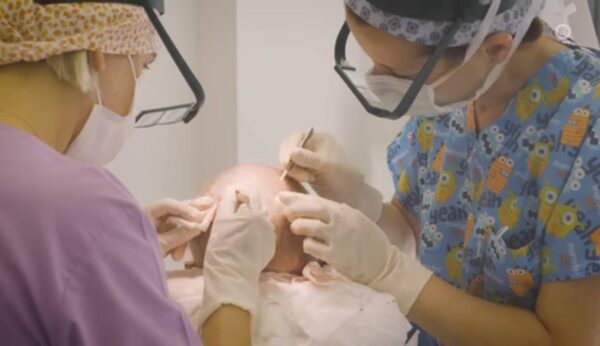Scrotoplasty is a surgical procedure designed to reconstruct or repair the scrotum, pouch of skin that contains the testicles. This specialized surgery is performed for various reasons, such as congenital abnormalities, trauma, gender-affirming surgeries or cosmetic enhancements. In this article, we look into the details of scrotoplasty, benefits, risks and recovery process, providing a complete guide for those considering this procedure.
What is Scrotoplasty?
Scrotoplasty, (scrotal reconstruction surgery) creation or repair of the scrotum. This procedure is typically performed by urologists or plastic surgeons who specialize in genital reconstruction. Depending on the patient’s needs, scrotoplasty can be a standalone surgery or part of a broader set of procedures.
Reasons for Scrotoplasty
There are several medical and personal reasons why people choose scrotoplasty:
- Congenital Conditions: Certain birth defects, such as undescended testicles or underdeveloped scrotum, can necessitate scrotoplasty.
- Trauma or Injury: Accidents or injuries that damage the scrotum might require surgical intervention to restore functionality and appearance.
- Gender-Affirming Surgery: For transgender men, scrotoplasty is an essential component of female-to-male (FTM) gender-affirming surgeries. It involves creating a scrotum using existing tissue and often inserting testicular implants.
- Cosmetic Reasons: Some people seek scrotoplasty to enhance the appearance of their scrotum or address concerns such as asymmetry or sagging.
- Medical Conditions: Scrotoplasty may also be performed for conditions like lymphedema or chronic infections that affect the scrotum.
Types of Scrotoplasty Procedures
There are different types of scrotoplasty procedures. Here are most common types:
- Scrotal Reconstruction: Rebuilding the scrotum after trauma, infection or surgery.
- Scrotal Reduction: Reducing the size of the scrotum to alleviate discomfort or improve appearance.
- Gender-Affirming Scrotoplasty: Constructing a scrotum for transgender men, often using labial tissue.
- Implant Insertion: Inserting testicular implants for cosmetic or reconstructive purposes.
Scrotoplasty Procedure
Pre-Operative Preparation
Before undergoing scrotoplasty, patients must undergo a thorough medical evaluation.
- Consultation: Discussing goals, medical history and potential risks with the surgeon.
- Imaging and Tests: Being sure for the patient is healthy enough for surgery.
- Smoking Cessation: Avoiding tobacco products to promote healing.
Surgical Process
Exact technique used during scrotoplasty varies based on the type of procedure. But mıst common techniques are :
- Anesthesia: Procedure is typically performed under general or local anesthesia.
- Incisions: Surgeon makes precise incisions to access or create the scrotal area.
- Tissue Manipulation: Depending on the procedure, tissue may be removed, reshaped or reconstructed.
- Implants (if applicable): Testicular implants may be inserted for aesthetic or reconstructive purposes.
- Closure: Incisions are carefully sutured to promote minimal scarring.



Recovery and Aftercare of Scrotoplasty
Recovery from scrotoplasty could be change according to the complexity of the surgery. But common avarage times:
Immediate Post-Surgery Care
- Pain Management: Pain and swelling are common but manageable with prescribed medications.
- Dressing and Support: The area is typically dressed and supported with a compression garment.
- Hospital Stay: Most patients can return home the same day, although more extensive surgeries might require an overnight stay.
Long-Term Recovery
- Healing Time: Full recovery may take 4 to 6 weeks. During this time, physical activity should be limited.
- Follow-Up Appointments: Regular check-ups are very helpful for healing and address complications.
- Hygiene: Keeping the surgical area clean reduces the risk of infection.
Risks and Complications of Scrotoplasty
As with any surgical procedure, scrotoplasty comes with potential risks. Such as:
- Infection: Proper hygiene and care minimize this risk.
- Bleeding: Minor bleeding is common,but excessive bleeding requires immediate attention.
- Scarring: Skilled surgeons aim to minimize visible scars.
- Implant Issues: In rare cases, implants may shift or be rejected by the body.
- Sensation Changes: Temporary or permanent changes in sensation may occur.
Benefits of Scrotoplasty
Scrotoplasty offers numerous physical and psychological benefits.
- Improved Aesthetics: Enhances the appearance of the scrotum, helping people feel more confident in their body image. This is particularly important for patients undergoing gender-affirming surgeries or cosmetic procedures.
- Restored Functionality: For those with congenital abnormalities or trauma, scrotoplasty can restore normal anatomical function and improving urinary and sexual health.
- Gender Affirmation: Scrotoplasty is a critical component of the gender-affirming process for transgender people, helping align their physical body with their gender identity.
- Relief from Discomfort: In cases of oversized or sagging scrotum, scrotoplasty can alleviate physical discomfort, making activities like walking, running or sitting more comfortable.
- Emotional Well-Being: By addressing aesthetic or functional concerns, scrotoplasty can significantly enhance self-esteem and quality of life.
- Reduction of Chronic Conditions: For people dealing with recurrent infections or conditions like lymphedema, scrotoplasty could be very helpful for relief and improved health.
Numbers and Statistics About Scrotoplasty
Scrotoplasty (while not as commonly discussed as other surgical procedures) is gaining attention due to its life-enhancing benefits. Here are some statistics about scrotoplasty:
- Prevalence: Each year, thousands of scrotoplasty procedures are performed globally, with a significant portion being part of gender-affirming surgeries.
- Gender-Affirming Surgeries: According to recent studies, about 25-30% of transgender men undergoing bottom surgery opt for scrotoplasty.
- Satisfaction Rates: Surveys indicate a high satisfaction rate among patients, with over 85% reporting significant improvement in quality of life and self-esteem.
- Complication Rates: Modern techniques and experienced surgeons have reduced complication rates to less than 5% in most cases.
These figures highlight the growing recognition and success of scrotoplasty as a transformative procedure.
Costs of Scrotoplasty
Cost of scrotoplasty can change significantly according to factors such as the type of procedure, the surgeon’s expertise and geographical location. Here is avarage costs of scrotoplasty:
- Gender-Affirming Scrotoplasty: Costs typically range from $5,000 to $15,000, depending on the complexity and inclusion of testicular implants.
- Cosmetic Scrotoplasty: Prices may range from $4,000 to $10,000.
- Reconstructive Scrotoplasty: Costs are often higher due to the complexity of the surgery and may exceed $20,000.



Frequently Asked Questions About Scrotoplasty
1. Who is a good candidate for scrotoplasty?
Good candidates are people in good health who have realistic expectations about the outcome. Ideal candidates may include those with congenital abnormalities, trauma-related injuries or people seeking gender-affirming surgery. Detailed consultation with a qualified surgeon can determine eligibility.
2. Is scrotoplasty covered by insurance?
Generaly insurance coverage depends on the reason for the procedure. Medically necessary surgeries (such as those for congenital conditions or trauma) are often covered. But cosmetic procedures could not be covered. Patients should verify coverage with their insurance provider.
3. How long does the surgery take?
Duration of scrotoplasty change based on the complexity of the procedure. Most surgeries take between 2 to 4 hours but combined procedures (such as gender-affirming surgeries) may take longer.
4. What is the recovery process like?
Recovery involves managing pain and swelling, keeping the area clean and attending follow-up appointments. Full recovery typically takes 4 to 6 weeks, with restrictions on physical activity during this time.
5. Can scrotoplasty be combined with other surgeries?
Yes, scrotoplasty can be part of a broader reconstructive or cosmetic plan. For instance, it is often combined with phalloplasty or vaginectomy in gender-affirming surgeries. Discussing goals with a surgeon helps tailor the procedure to needs.
6. Are there non-surgical alternatives to scrotoplasty?
Non-surgical options (like such as fillers for scrotal enhancement) can address cosmetic concerns but cannot provide the functional restoration achieved through surgery. For permanent results, scrotoplasty remains the preferred option.
7. Does scrotoplasty increase size?
Scrotoplasty can increase the size of the scrotum in cases where additional tissue or implants are used, like as in gender-affirming surgeries or cosmetic enhancements. But procedure’s primary goal is functional or aesthetic restoration rather than size enhancement.
8. How much does scrotoplasty cost in Turkey?
Cost of scrotoplasty in Turkey typically ranges from $2,000 to $7,000, according to change on complexity of the procedure, surgeon’s experience and the medical facility. Turkey is a popular destination for medical tourism due to its affordable prices and high-quality healthcare services. Additionally many clinics in Turkey offer all-inclusive packages covering the surgery, accommodation and transportation, making it a cost-effective option for international patients.
If you found this article helpful, consider sharing it with other people and freiend benefit from this information. For more articles on health and wellness, visit our website and explore our extensive resources.
We wish healthy and happy life to you.

